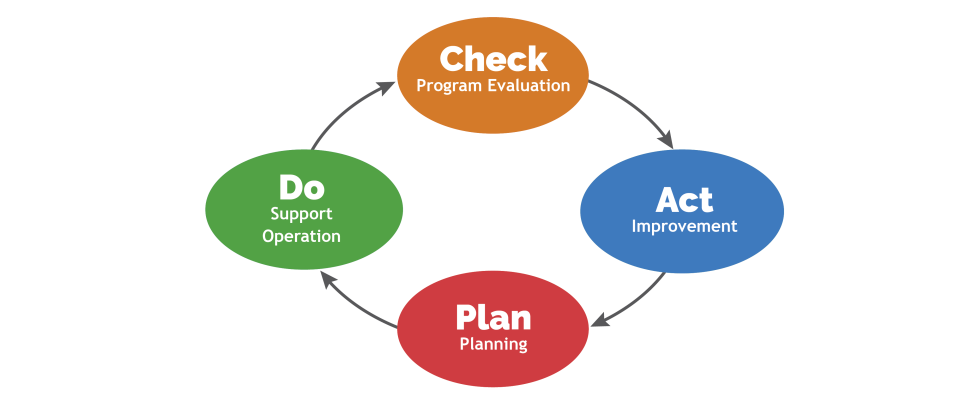Check - Evaluating Parts of an EMS
The next phase of the PDCA cycle is “Check.” During this phase, the organization evaluates various parts of its EMS. For example, the organization may monitor the efficacy of the selected approach; assess environmental performance; and review existing plans, procedures, and programs to determine how well they are working.

The information below illustrates the next five steps in the “Check” process. The tasks described in the “Plan” and “Do” phases should be completed prior to implementing these next steps.
- Step 18: Monitor/Measure and Document
- Step 19: Conduct Internal EMS Audits
- Step 20: Evaluate Compliance
- Step 21: Hold an Emergency Drill
- Step 22: Review EMS Policies and Procedures
Step 18: Monitor/Measure and Document
As part of the “Check” phase, the organization should monitor and measure its environmental performance, especially related to the following:
- Environmental Aspects
- Operational Controls
- Environmental Objectives
- Compliance Obligations
Monitoring and measuring allow organizations to assess whether they are meeting their commitments and environmental objectives. The activities empower organizations to be proactive in identifying potential problems or weaknesses and mitigating them before they blossom into bigger problems or have larger negative impacts on the environment. During this step, organizations evaluate “environmental indicators,” which are measurable metrics that provide information on the status of operations. Examples include gallons of water consumed per month, number of compostable items mistakenly thrown in landfill-bound trash (determined by a waste audit), or number of commuting trips made with bicycles rather than single-occupancy vehicles.
All monitoring and measuring data should be documented and maintained in a database so that the organization can assess how its environmental performance changes over time. Evaluation of the data will allow the organization to answer questions like these:
- Are the same or similar problems coming up repeatedly during facility walkthrough inspections?
- Are new procedures having a meaningful impact? For example, did electricity consumption decrease when the organization started performing nightly energy checks to find equipment that should be powered off when not in use?
Step 19: Conduct Internal EMS Audits
During an EMS audit, an objective and impartial party performs interviews and facility walkthroughs to determine whether the organization’s EMS conforms to its own policies and procedures. Such audits help reveal the system’s strengths, as well as areas that need to be improved. When first establishing an EMS, an organization may want to perform smaller, more frequent, limited-scope audits rather than auditing the entire EMS all at once. These early audits can be an effective learning tool. When determining the scope of each EMS audit, the EMS team should consider whether there have been any changes at the site since the previous audit (e.g., changes in the number of employees or types of activities and equipment; changes to compliance obligations; updates to procedures). The team should also consider whether monitoring data show any changes in environmental performance.
Results from an internal audit may include nonconformances, or ways in which the organization does not meet its EMS requirements. Instead of becoming discouraged by nonconformances, the EMS team should view them as opportunities to improve the EMS and the organization’s environmental performance. The team should respond to these nonconformances in a timely and thorough manner to correct existing weaknesses (see Step 23) and avoid any further environmental impacts or legal ramifications.
Step 20: Evaluate Compliance
Organizations must periodically examine whether they are meeting all their compliance obligations, including both mandatory requirements (dictated by laws and regulations) and voluntary commitments (like industry standards, agreements with community groups, and contractual relationships). The EMS team might choose to evaluate compliance during an EMS audit (described in Step 19) or at a separate time. When determining how often to evaluate compliance, the team should factor in the importance of the requirements, whether the requirements have changed recently, and the organization’s track record of meeting requirements. Any nonconformances identified should be addressed and corrected in a timely manner (see Step 23).
Step 21: Hold an Emergency Drill
Emergency Action Plans, which are developed during the “Plan” phase, must be tested during the “Check” phase by performing emergency drills. The drills assess the adequacy of the plans and deepen an organization’s understanding of potential vulnerabilities that require attention. This is critically important because emergency situations have the potential to create serious environmental impacts. After holding a drill, the organization should maintain a record of what went well and what needs improvement. The organization should also determine whether corrective actions are needed (see Step 23) and ask follow-up questions. For example, after conducting a spill drill, the organization should ask itself:
- How long did it take to contain the spill?
- Was it cleaned up using proper techniques and following established procedure?
- How can future spills be prevented?
Step 22: Review EMS Policies and Procedures
Reflection is a key element of the EMS model. Periodically, organizations should pause and review their EMS policies and procedures to determine if they are still adequate and effective. For example, organizations should ask themselves the following questions:
- Do policies and procedures need to be updated to reflect changes in operations?
- Are the policies and procedures effective? Are they allowing the organization to meet its environmental objectives? If not, what changes might be necessary?
